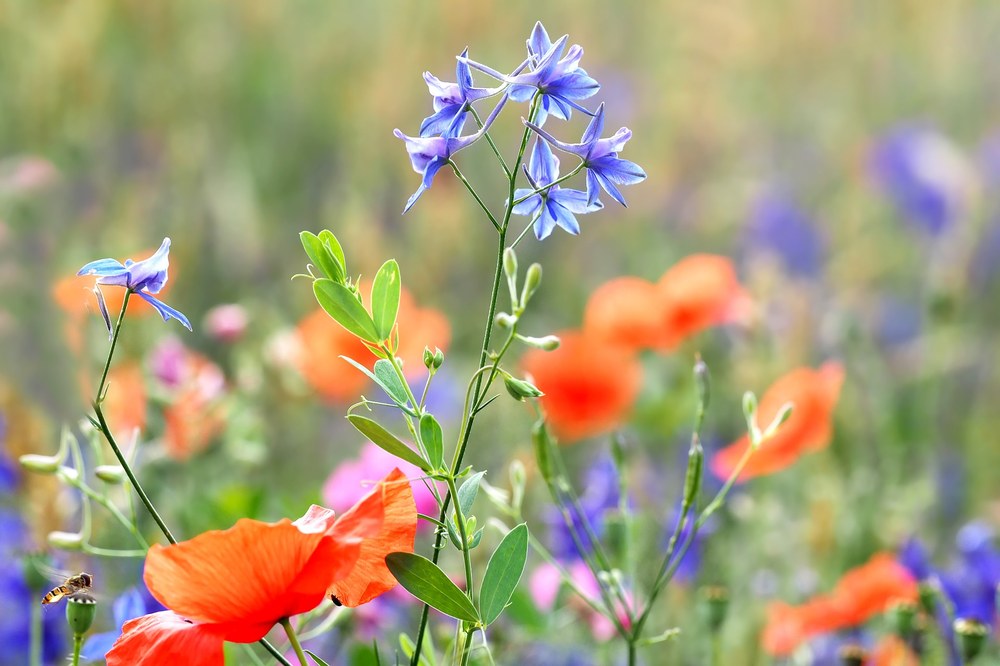Posted: July 21, 2021
The language of flowers is a fascinating study because of the many meanings folklore and tradition have given flowers throughout history. There are flowers designated for each month of the year as one’s birth month flower. July’s birth flower is larkspur.

Photo from Pixabay
Larkspur appears in Various historical stories. According to Greek mythology, this flower is tied to the Battle of Troy. The beloved warrior, Achilles, died in the battle and both Ulysses and Ajax claimed Achilles' armor. Ulysses was ultimately awarded the fallen hero's armor. Furious over the decision, Ajax threw himself on his sword, and larkspur flowers blossomed where his blood spilled onto the ground. The Greeks named the flower Delphinium because its blooms resemble a dolphin's (delphis) nose. The ancient Romans also used the dolphin description and believed that the god Neptune transformed an endangered dolphin into the flower for protection.
In England, people sprinkled larkspur in their bathwater to protect themselves from ghosts and magic. It was also believed to provide protection against lightning. In Transylvania it was planted around stables, allegedly to keep witches away. In medieval Italy, the larkspur appeared when three warriors slew a fierce dragon and wiped their swords in the grass. The dragon's blue blood and venom mingled to create a beautiful but poisonous blue flower.
The Pawnee tribe of North America believed in a mythological figure, "Dream Woman," who cut a hole in the sky to look down on Earth beings. Crumbs from the blue sky fell to the ground and became larkspur. And like lily of the valley, larkspur is also associated with the Virgin Mary and is said to represent her tears.
Larkspur is symbolic of a beautiful spirit, swiftness and generally of positivity and strong bonds of love. It is also associated with lightheartedness and youth, possibly because it grows in summer where carefree days are spent away from school.
As with many flowers, each color of the larkspur is associated with a more specific meaning.
- Blue larkspur- symbolizes dignity and grace
- Pink larkspur-means contrariness or fickleness
- White larkspur- conveys a happy nature
- Purple larkspur- represents first love
Larkspur is said to get its name from its long petal that resembles a silver spur of a medieval knight, and the claws of the Meadowlark bird. The larkspur was also called "Lark's Heel" by Shakespeare, and has been referred to as "Lark's Claw" and "Knight's Spur."
Larkspur vs. Delphinium
Larkspur is a common name often used interchangeably with delphinium. Larkspur is also considered the common name for annual species in the genus Consolida. Foliage of larkspur is finer textured than delphinium. Delphinium flowers are densely set on spikes while individual blossoms tend to be much larger than larkspur. With these few exceptions, general plant care and maintenance is the same, and the names are often used interchangeably.
Larkspur grows wild in the United States and Europe. Three species of larkspur were introduced into English gardens from Italy in the mid 1500s. They became instant favorites and were often used in pleasure gardens built during this period. They were introduced into American gardens during the pre-Revolutionary era.
Larkspur is a low-maintenance plant that grows easily from seed. It will sprout and begin blooming when the weather warms in spring. Because it is a cool-season annual, sow seeds in early spring in more northern climates such as Pennsylvania. Plants can last into the summer in Pennsylvania before the weather gets too warm.
Larkspur needs either full sun or at least 6 hours of sunlight. It thrives in slightly alkaline soil that is well-drained. It needs consistent moisture but doesn't like to be wet for long periods of time. Long periods of dryness can result in stunted plants or blooms. It grows 1 -3 feet tall and 6-18 inches wide.
The flowers grow in groups along a single stalk and each flower has five petals and a protruding center or "spur." This long, nectary spur protrudes backwards from the flower and is attractive to pollinators. Both single and double forms are available and deadheading spent blooms help the plant produce more flowers. Light airy foliage is blue-green and fern-like, adding to the beauty of the plant.
Larkspur belongs to the buttercup family. It contains toxic alkaloids and all parts of this plant are highly poisonous if ingested. It has been responsible for many cattle deaths in areas where it grows wild in pastures. Deer avoid eating it.
Larkspur can be susceptible to powdery mildew, botrytis blight, leaf spots, and crown rot. Slugs and snails may also be a problem. Tall plants may require support to keep them upright and off the ground.
Late spring can be a time of transition in the flower garden. Showy springtime blooms are over and summer annuals have not yet filled in to provide their own colorful background. It's during this period that the larkspur provides beautiful color and bluish-green foliage to fill the void.
Larkspur is a cottage garden staple especially when grown in masses. Fill them among bulb plantings, as a companion to roses, or in the perennial garden. It also makes attractive border plants. Larkspur provides interest to flower pots or in container gardening, provided that the containers can support tall plants. Otherwise supports may be needed to keep them upright. Finally, larkspur is popular for cut flowers arrangements both indoors and out. However, when handling or decorating with them, keep their highly toxic nature in mind and locate them away from children and pets.
The beautiful July larkspur is a colorful, popular, and versatile choice for enjoying summer color!
by Joan Banyas, Penn State Master Gardener Trainee of Luzerne County

